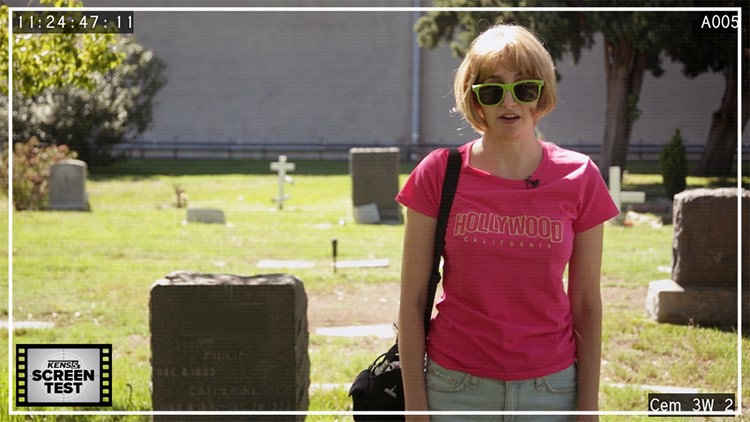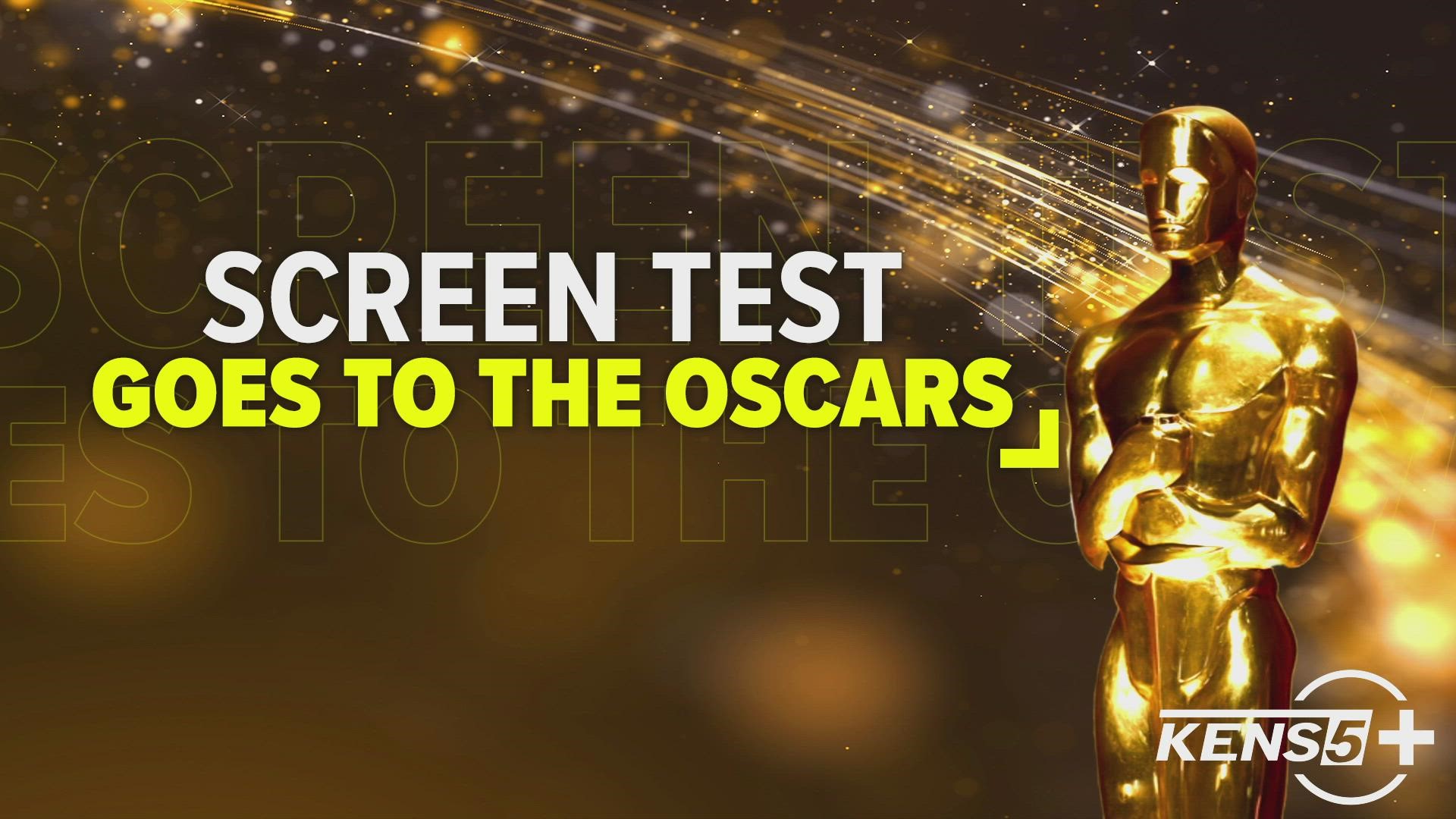In the playfully rebellious new movie “I Blame Society,” the young filmmaker Gillian Wallace Horvat steps in front of her camera to give one of the most unpredictably self-aware performances since, well...whatever it is the last thing Nicolas Cage did. Whether that makes it a great performance is a different question. But if one barometer of an actor’s effectiveness is how confidently they skate right up to the edge of incredulity without slipping over, then the answer is leaning towards the affirmative.
Embodying a cheerily anarchic reflection of herself come undone by the routine compartmentalization of women in a male-dominated movie industry, Horvat deploys the practicality and studiousness of a haven’t-quite-made-it-but-not-for-lack-of-trying director as her fictionalized persona crafts sketchy schemes with a smirk and a twitchy wink. She’s also a stiff presence on the screen, at times maneuvering physical spaces on what seems to be an invisible swivel, and if you’re unconvinced by the way Horvat breaks down into tears early on, that’s part of the point—in riffing on what we think we’re talking about when we talk about “creative differences” in modern moviemaking, “I Blame Society” blurs the line between sincerity and artifice, documentary and autofiction, conforming to the norm and reveling in individual artistic liberty. Horvat’s motivations feel personal, and indeed they are; the experiences of a tireless artist are stretched into the territory of genre as Horvat turns re-enactment into its own kind of cinematic vengeance.
The results are a mixed bag, which is admittedly funny to say about a movie that feels destined for that love-it-or-hate-it tier of unapologetically uncouth cinema. This is both Horvat’s first feature (she’s pulling triple duty as director, writer and actor) and the first time she has acted in a leading live-action role, and her refuting the most basic of audience expectations creates a disarming attempt to comment on the industry she’s spent the better part of the last 15 years navigating. That context is important, but it’s also not enough to keep the movie around her from awkwardly wavering between being prickly in its themes and being a pincushion.
Disorientation is the movie’s intriguing M.O., and it’s deployed from the jump as Gillian seeks feedback on a new project inspired by a friend’s offhand comment that she’d “make a good murderer.” The candid opening sequence is shot candidly, written candidly and paced a bit too candidly, to the point that we suspect we’re seeing a recreation of an interaction Horvat had in real life—the same goes for much of what’s to come over 90 minutes. Go into “I Blame Society” totally blind and you may find a particular thrill in wondering, Hold on…is this actual documentary? as we’re absorbed into the frustrations of a women filmmaker whose vision is neutered at the hands of suspect would-be collaborators.
Horvat and her collaborators, though, are impressively committed to the bit: There’s the shaky handheld camerawork, the unguarded intimacy, the sensation of epiphanies being arrived at in real time during conversations with her boyfriend. Gilllian, a bit sheepish but also quietly relentless, sneakily films her conversations via GoPro, which helps construct a convincing sense of improvised reality that defines the early segments of “I Blame Society; there’s an acute degree of difficulty in the filmmaking that’s deftly maneuvered even as it borders on parody. It’s virtually invisible until you realize what kind of movie you’re really watching.
Ironically, that’s also the point where the façade begins to crack. “I Blame Society” eventually arrives at a bloody rendezvous when every viewer will get locked into the movie’s satirical properties, and as Gillian’s search for validation takes increasingly unsettling detours into serial killerdom, the potential for new revelations about lower-tier Hollywood ambition is muddled. A lack of urgency betrays an aimlessness in the film’s increasingly deranged second half, and we become more likely to view its ironies as happy accidents rather than the bounty of focused intention. That’s especially true when it comes to the stilted performances around Horvat; filling out the movie’s cast are a collection of dead-eyed turns that lack a similar sense of purpose the writer-director brings to her own character, and it becomes distractedly difficult not to imagine how much more successful the movie could be if its actors juxtaposed each other in their approaches.
At the same time, and at a time when it’s increasingly rare for movies to keep us on our toes, you can’t help but admire Horvat’s insistence to shove the status quo into the sidelines. Her screenplay (specifically, the movie-within-a-movie structure that fuels it) creates spaces for some hilariously cruel asides, and watching Gillian occupy them makes for a devilishly good time. There’s a delicious novelty to the director playing her own unhinged surrogate – imagine if Christopher Nolan had stepped into the role of Robert Pattinson’s dapper sidekick in “Tenet” – even if no one other than Horvat herself can fully appreciate the catharsis of such a meta tactic.
Gillian at one point laments the “drastic tone changes I didn’t anticipate” about her killing-spree-as-movie, and even as “I Blame Society” makes explicit overtures to its inherent touch of cheapness, her wry plain-statedness is practically a middle finger to Hollywood’s typically shallow interpretations of what makes a "strong female lead." Where those motivations ultimately take her (“her” here referring to both Horvat in reality and Gillian in the movie) is more likely to get your blood pumping than challenge your perspectives; in this case of creative transposition, retaining integrity means disposing of it with the plunge of a knife.
"I Blame Society" is not rated. It will be available to watch in virtual cinemas via Cranked Up Films on Friday, and on VOD on Feb. 12.
Starring: Gillian Wallace Horvat, Keith Poulson, Chase Williamson, Lucas Kavner
Directed by Gillian Wallace Horvat
2021
OTHER SCREEN TEST REVIEWS:
- ‘News of the World’ Review: Tom Hanks travels across post-Civil War Texas in airy, occasionally intelligent Western
- ‘Soul’ Review: Pixar prioritizes concept over character in its most literal meaning-of-life tale yet
- ‘Another Round’ Review: Mads Mikkelsen experiments with endless drinking in bittersweet Danish drama
- ‘Tenet’ Review: Christopher Nolan’s time-bending exercise was made for an audience of one
- The best movies of 2020



